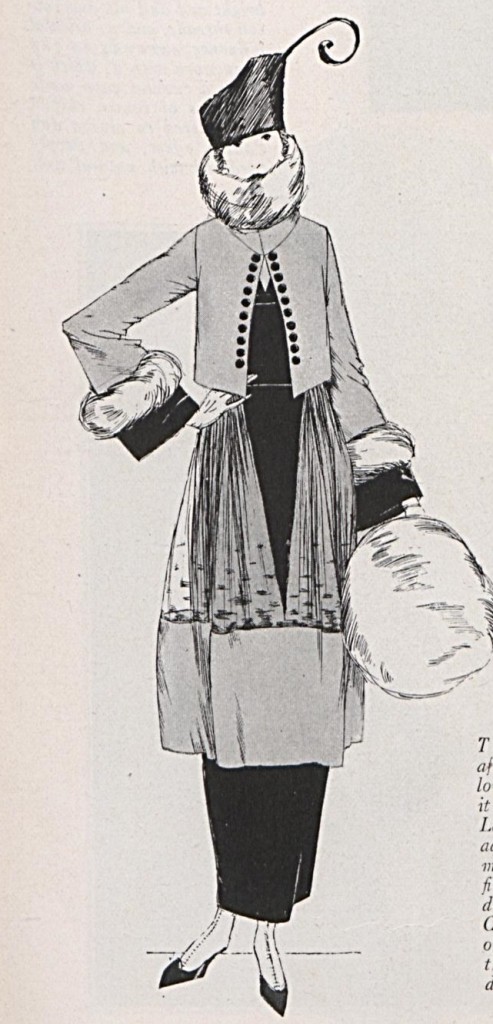By the end of September 1918 the German bombardment of Paris had ceased, as the allies had started to push the German army out of France. The changing mood in France as a victorious end to the war seemed in sight was noted in fashion reports in Vogue titled ‘Paris Openings are Keyed to Victory’ and ‘The New Note of Hope in Paris Fashions’. This new note was evident in a return to decorative trim and feminine detailing such as ruffles and wide sashes. A newly fashionable fabric was silk batik, introduced to Paris by a Madame Pangon, who was producing designs ‘coming from the Orient but improved by French taste’. Her work was seen by Vogue as a worthy heir of Fortuny’s ‘art fabrics’, capable of being personalized to suit individual clients. Best of all – Mme Pangon was employing wounded soldiers in her workshops.
Other fabrics noted in Vogue were ones which had not normally been accepted in high-end fashion – cotton velvet and thick duvetyn to replace heavy wool, and net to replace bobbin lace. Substitutes for the wool fabric that had been requisitioned for army uniforms took several surprising forms. One was the use of angora rabbit yarn heavily embroidered onto a light fabric to create a fluffy textured surface. Another was the use of ‘shoddy’ – fabric made from recycled wool fibres that had long been a byword for poor quality.
Scarcity of fashion fabrics could also be seen in some of the couture ensembles praised for their innovation. Louise Cheruit was one of several designers making outfits that fulfilled the functions of a dress for indoor social events and a suit for street wear – either with a coat-dress, or as shown above, with a dress cut like a skirt and contrasting blouse worn under a short coat to make a suit. In this outfit decorative panels of gold brocade are restricted to the sides of the bodice section, contrasting with sober black velvet for the skirt and coat. An even more striking combination of fabrics is shown in an ‘all-day’ ensemble by the couture house of Boue Soeurs: a plain black satin sheath dress for wearing at home that could be topped by a full tunic of rust coloured net for entertaining; then a jacket of rust coloured wool could be added for street wear. The result harks back to Poiret’s ‘Minaret’ line of 1913, with the short buttoned jacket referencing both English schoolboys and Ottoman Zouave uniforms. There is a suspicion here, as there is in some of the knee-length dresses by Premet featured elsewhere in this issue, that a virtue is being made out of the absolute necessity to save fabric.
One article in this issue looks back over the changes made by wartime to the wardrobes of Vogue readers. This is illuminating, as the ideal reader was a leisured lady – one who employed a lady’s maid capable of running up flattering accessories to update her mistress’ wardrobe, no less! Readers were advised not to allow wartime price increases to get the better of them, but to choose key wardrobe pieces carefully. A column on ‘Dressing on a war budget’ described a number of suits and dresses that were presented as good investments, costing between $100 and $125. This was a high price – in the 1920 census, 70% of US workers earned less than $3,000 a year, and for them $100 be the equivalent of two weeks’ wages. Even so, war restrictions had made some healthy changes in the landscape of fashion:
Probably for the first time in the history of dress the talented designers are giving their attention to the creating of women’s working clothes. Heretofore the woman who took part in any occupation dressed in imitation of her less industrious sister of leisure, and her clothes were seldom designed primarily for her occupation. To-day all women work. This means that many women who have been accustomed to dress the part they play with the utmost attention to appropriateness, charm, and chic, are now striving to dress the part of the woman who works. Some very successful clothes have been designed for the woman who is serving her country in a capacity that does not call for a uniform.
Business clothes for women were not a novelty in 1918 – the 1890s had seen a wave of ‘white blouse’ jobs created for women office workers, who in their turn created a demand for affordable business clothing. But the rhetoric of efficiency in elite women’s wardrobes was new and would be taken even further in the shift dresses and cardigan suits of the 1920s.




